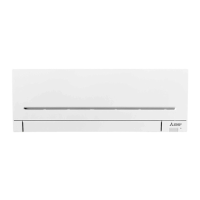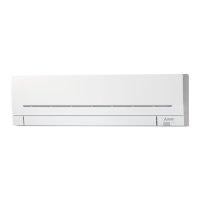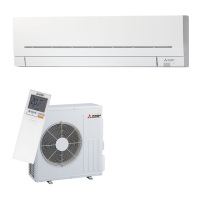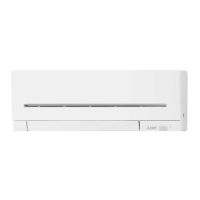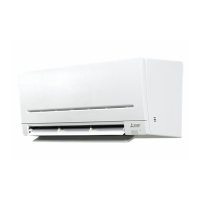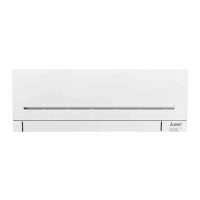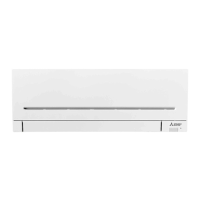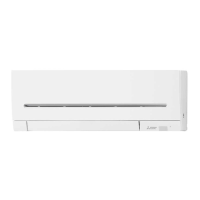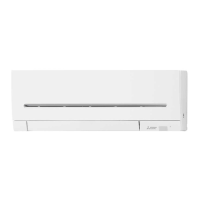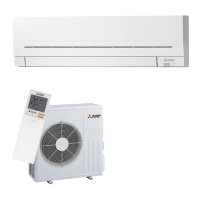
Do you have a question about the Mitsubishi Electric MSZ-AP60VGKD and is the answer not in the manual?
| Cooling Capacity | 6.0 kW |
|---|---|
| Heating Capacity | 6.8 kW |
| Energy Efficiency Ratio (EER) | 3.21 |
| Power Supply | 220-240 V, 50 Hz |
| Energy Efficiency Class Cooling | A++ |
| Energy Efficiency Class Heating | A+ |
| Refrigerant | R32 |
| Noise Level (Outdoor Unit) | 50 dB |
Lists the indoor unit model numbers MSZ-AP60VGD, MSZ-AP71VGD, MSZ-AP60VGKD, MSZ-AP71VGKD.
Advises users to read operating instructions before use for safe operation.
Explains warning symbols and their associated hazards and precautions for safe operation.
Provides essential safety warnings regarding power cords, plugs, and direct exposure to cool air.
Warns against user installation, relocation, disassembly, or repair, advising consultation with dealers.
Details risks associated with refrigerant leaks, fire, and the use of specified refrigerants.
Covers safety during operation, cleaning, and handling of the unit and its parts.
Warns against operating in high humidity, using for special purposes, and exposing combustion appliances to airflow.
Recommends cleaning filters every 2 weeks to prevent condensation and fungi growth.
Outlines safety precautions for installing the air conditioner, including dedicated power supply and earthing.
Details warnings and precautions for using the Wi-Fi interface, especially near medical equipment.
Identifies and illustrates the main parts of the indoor unit, including filters, vanes, and indicators.
Shows the remote controller layout and explains the function of its buttons and the remote controller holder.
Illustrates the outdoor unit and its main connections like air inlet, outlet, and piping.
Provides instructions for inserting batteries into the remote controller, including notes on polarity and battery types.
Guides the user on how to set the current time and day on the remote controller for timer functions.
Explains how to assign a remote controller to a specific indoor unit in multi-unit systems.
Details the DRY, HEAT, and FAN modes, explaining their functions and usage.
Instructs on how to start and stop the air conditioner using the ON/OFF button and select modes.
Explains how to adjust the set temperature using the TEMP buttons on the remote controller.
Describes the AUTO mode, where the unit automatically selects cooling or heating based on room temperature.
Explains the COOL mode for cooling the room and notes precautions for low outside temperatures.
Details how to adjust the vertical airflow direction using the VANE button, including manual and swing options.
Explains how to select different fan speeds (AUTO, Quiet, Low, Med, High, Super High) for comfort and efficiency.
Describes how to adjust the horizontal airflow direction using the WIDE VANE button, including manual and swing options.
Explains the LONG operation for reaching distant areas and its cancellation.
Describes the I-SAVE function for saving and recalling preferred settings with a single button press.
Details the POWERFUL operation for quick cooling or heating and its cancellation conditions.
Explains the ECONO COOL mode, which uses swing airflow to feel cooler and save energy.
Describes the NIGHT MODE, which adjusts indicator brightness, beep sounds, and outdoor unit noise.
Guides on setting ON and OFF timers for automatic operation start and stop times.
Explains how to use the emergency operation switch on the indoor unit when the remote is unavailable.
Describes the auto restart function that resumes operation after a power failure.
Provides step-by-step instructions for setting up ON/OFF times for each day of the week.
Explains how to view or confirm the programmed weekly timer settings.
Details the three Demand Response Modes (DRM 1, 2, 3) and their impact on operation and indicator lamps.
Provides general instructions for cleaning the unit safely, including what not to use.
Details the procedure for removing and cleaning the front panel of the indoor unit.
Explains how to clean the air purifying filter and the air cleaning filters (Anti-Allergy Enzyme).
Introduces the Wi-Fi interface and outlines two connection options: Access Point Mode and WPS-Push Pairing.
Guides users through setting up the Wi-Fi interface in Access Point Mode and connecting their smartphone.
Explains the WPS-Push pairing method for connecting the Wi-Fi interface to a router.
Provides detailed steps for WPS-Push pairing, including router activation and interface button presses.
Explains the meaning of different LED patterns on the Wi-Fi interface for various states like software initialization and connection.
Lists common connection problems and their likely causes, such as server or router connection failures.
Mentions the requirement for user registration and acceptance of terms for Wi-Fi service activation.
Addresses common issues with the indoor unit, like no operation, vane movement, mist discharge, and sounds.
Covers troubleshooting for the outdoor unit, including fan rotation, water leakage, and white smoke.
Lists problems with the remote controller, such as display issues or lack of response from the indoor unit.
Explains issues related to unit operation, sounds, and timer malfunctions.
Lists critical problems like leaks, blinking lamps, frequent breaker trips, or abnormal sounds requiring dealer service.
Guides on operating the unit in COOL or FAN mode to dry the interior before long-term storage.
Advises on suitable and unsuitable locations for installing the air conditioner and Wi-Fi interface.
Details the guaranteed operating temperature and humidity ranges for cooling and heating.
Lists technical specifications for the Wi-Fi interface, including model, voltage, power consumption, and wireless standards.
Provides fields to record Wi-Fi interface setup details like MAC address, SSID, and installation date.
